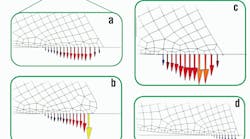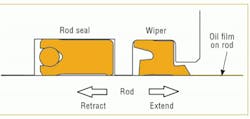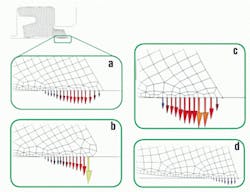The sealing package in a hydraulic cylinder is composed of a rod seal, back-up rings, and wiper, all of which must work together to provide leak-free high performance. Dozens of potential causes for rod seal leakage of a hydraulic cylinder exist, including a damaged rod, damaged seal, inadequate rod surface finish, and incorrect gland dimensions. An often overlooked culprit of rod seal leakage is wiper aggressiveness.
The function of the rod wiper is to prevent the ingression of foreign particles like dirt and dust into the hydraulic fluid where they can damage the system, reduce cylinder performance, and cause leaking. Intuitively, it stands to reason that the more aggressive the wiper (or the greater the sealing force against the rod), the better it is at doing its job. In studying the mechanisms for cylinder leakage, my colleagues and I determined design features that cause wipers to be too aggressive and actually cause leakage.
How does a rod wiper cause leakage?
In a rod sealing system, such as that shown in Figure 1, it may not be immediately clear how a wiper could be the cause of leakage. The answer has to do with a very thin oil film that the rod seal leaves on the rod as it cycles. This thin oil film provides beneficial lubrication at the dynamic interface between the sealing components and the rod. The thickness of the film is typically on the order of only a few microns; thin enough to be undetectable by sight or touch. The magnitude of this film is a function of the aggressiveness (sealing force) of the rod seal, rod surface finish, oil viscosity, and rod speed. It can be determined for either the extend or retract stroke from the formula,
t = [(2 • µ • v) ÷ (9 •P´)]1/2
where t is the oil film thickness,
µ is the oil dynamic viscosity,
v is the stroke speed, and
P’ is the maximum contact pressure per unit length (maximum pressure gradient). This equation indicates that a low stroke speed or a high contact pressure gradient are needed to cause the oil film thickness to approach zero.
Wiper design optimization
When designing the rod wiper, achieving a balance between enough sealing force to prevent contamination ingression but not so much as to cut the hydrodynamic film is key to a high-performance, leak-free cylinder. Lip aggressiveness is a function of the total contact force exerted on the rod, the contact force gradient going in the retract direction, and the shape of the lip. Potential design modifications to reduce wiper lip aggressiveness include:
• a radius at the leading edge of the wiper lip,
• decreasing the wiper lip interference with the rod, and
• making the lip thinner (more flexible).
Parker engineers used axi-symmetric FEA models to examine and compare the contact force footprints of each of these concepts. Output from these models is shown in Figures 2 through 5. The wiper design that leaked in the functional tests is used as a benchmark in this analysis and is shown in Figure 2. Figures 3-5 show the comparative theoretical results of the design modifications mentioned above. The size and color of the arrows in each figure indicate the magnitude of the contact normal force against the rod at each respective node.
The rounded lip in Figure 3 has a slightly smaller contact area, thus creating a concentrated force near the tip of the lip. From a force gradient perspective, this indicates an even more aggressive design than the baseline. From a geometry point of view, the shape of this lip will have poor ingression resistance, as it basically funnels contamination toward the rod. Experience and testing have shown that a sharp lip is optimal to keep out small foreign debris and to minimize water ingression into the gland area and into the oil.
The wiper lip shown in Figure 4 is a trimmed version of the baseline wiper lip, to lessen its interference with the rod. Even though there is less interference, the FEA model actually calculates a higher contact force and stress gradient. The reason for this is that the “stubby” shape of the lip does not allow it to flex as easily, thus causing the tip of the lip to be compressed more directly against the rod.
Summary
Optimizing the rod wiper design for a given rod sealing package is key to leak-free performance. A wiper with too high a force gradient or too much sealing force compared to the sealing gradient and force of the rod seal will cause leakage to occur. The wiper lip geometry can also compromise a rod sealing system and create other problems when it is not aggressive enough to keep contamination from getting past the excluder lip. The optimal wiper for a given application may not be best for all applications, but knowing how the wiper influences the performance of the rod seal is key to having a long-life, leak-free cylinder.
For more information, contact Parker Hannifin’s Engineered Polymer Systems Div., Salt Lake City, at www.parker.com/eps.





